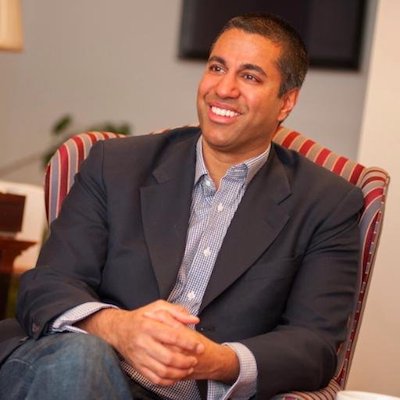On Thursday, December 14th, the commissioners of the Federal Communications Commission (FCC) will convene an open meeting to discuss several subjects, one of which is titled Restoring Internet Freedom. According to news reports, the FCC is likely to approve this order in a 3-2 vote along party lines to return the classification of broadband Internet access service to its prior classification as information service. The order would also reduce regulations on mobile broadband services and restore the authority of the Federal Trade Commission (FTC) as the agency in charge of policing Internet service provider (ISP) privacy practices.
Despite the high likelihood that the order will be passed by the FCC’s commissioners, or maybe more because of that likelihood, there has been a lot of recent press on how the FCC under current Chairman Ajit Pai has drawn the ire of net neutrality supporters. The New York Times recently reported on hundreds of protests being held ahead of the FCC’s December 14th vote and how organizations supporting net neutrality have been using social media to foment opposition to Pai. News headlines have been rife with doomsday predictions that the plans to reclassify broadband Internet as an information service will “ruin the Internet,” “kill the careers of indie musicians” and some have even suggested that the reclassification will negatively impact those with disabilities.
Given all this negative feedback over the repeal of what many feel is a basic tenet of net neutrality principles, it would be interesting to know what reasoning Chairman Pai is employing in rescinding aspects of the 2015 Open Internet Order put in place by former FCC Chairman Tom Wheeler. In an opinion piece published this April by The Los Angeles Times, Pai argued that fears over fears regarding the potential of fast and slow lanes on the Internet led to the adoption of an old regulatory framework meant to control former monopolies like Bell System in a way that has negatively impacted both ISPs and the rollout of American broadband infrastructure. Research released this March indicates that the top 12 broadband Internet firms, including entities like AT&T (NYSE:T), Verizon (NYSE:VZ) and Comcast (NASDAQ:CMCSA), reduced their domestic broadband capital expenditures by $3.6 billion relative to 2014, the last year in which ISPs were not affected by Title II regulations. That amount represented a 5.6 percent decline in broadband infrastructure during the time in which ISPs were classified as Title II utilities.
It’s not just large ISP entities who are finding their fortunes to be negatively impacted under Title II regulations. On December 8th, the FCC issued a press release to announce that Chairman Pai had spoken with a series of executives from small ISPs from rural areas in Minnesota, Montana, North Dakota and elsewhere to hear their concerns on how Title II regulation under the current net neutrality regime has impacted their ability to build broadband infrastructure. In the release, Pai said that common themes of those discussions included how Title II regulations have both slowed investments and injected regulatory uncertainty into the business plans of ISPs. Specific instances mentioned include increased costs stemming from increased time spent with lawyers and increased interest rates from banks for financing. Multiple executives noted that increased costs have led to a reduced capability to lay new fiber optic cable or just generally improving investments in consumer services.
Public comments filed with the FCC from rural broadband advocates further indicate that the Title II regulatory regime under the Open Internet Order has done a lot to undermine rural broadband deployment. In May 2016, WTA – Advocates for Rural Broadband filed public comments on proposed rules regarding consumer privacy and ISP data collection which the FCC issued using its Title II common carrier regulatory authority. As WTA noted:
“At a time when small rural providers are seeing decreasing federal and state universal service support while subject to increasing deployment obligations, overly restrictive privacy requirements that necessitate expensive compliance programs will only divert funds towards regulatory compliance and away from broadband buildout in rural areas where such investment is critically needed.”
Along with increased costs, WTA noted that providing different regulatory standards to broadband Internet access services than are applied to other participants in the online ecosystem, including social media and search engines, could create consumer confusion as to which heightened standards applied to which Internet companies. Further, WTA asked the FCC to consider calibrating rules and expectations with the regulatory activity of the FTC, the agency which regulated ISP business activity prior to the Open Internet Order.
The fact that the Title II regulatory regime has hurt investment into Internet broadband infrastructure deployment for large and small ISPs alike seems remarkable given at least some of the reasoning behind the FCC’s 2015 Open Internet Order. The official order cites to the 2015 Broadband Progress Report, an FCC document released in February 2015 which concluded that broadband deployment, “especially in rural areas,” was failing to keep pace with the state of tech developments in the field. In those rural areas, 22 million Americans, or 53 percent of the country’s rural population, lacked access to Internet which could provide download speeds of 25 megabits per second (Mbps) and upload speeds of 3 Mbps. By contrast, only 8 percent of the country’s urban population lacked access to such services.
Further, the language of the Open Internet Order itself seems to contemplate how beneficial the order would be to the rollout of broadband infrastructure in rural areas. In reclassifying broadband Internet access services as Title II common carriers, Tom Wheeler’s FCC exercised broad forbearance of Title II rules in an attempt to create a light-touch regulatory framework. In finding that the statutory test for forbearance from 47 U.S.C. § 254, which governs the FCC’s regulatory approach to universal service, was met by the order, the FCC determined that the application of Section 254 provides legal certainty for offering service subsidies for the deployment of broadband networks, “including rural and low-income Americans.” In contemplating why the FCC was compelled to act to preserve an open Internet, the agency opined that the rules “are also critical for ensuring that people living and working in rural areas can take advantage of the substantial benefits that the open Internet has to offer.” It seems worth questioning, given the effects of Title II reclassification of broadband Internet access services on rural providers, whether the rules are achieving what they were supposed to achieve.
Analysis of the impact of open Internet rules on the cable industry calls the effects of the rules on competition among companies in the cable industry into question. A piece published in September 2015 by The Wall Street Journal discussed the effects of FCC regulatory activity on the cable and mobile industries, concluding that regulations in the telecommunications industry had done a better job of aiding industry incumbents in the broadband Internet market than they did at increasing competition in the sector. “[I]t will be a surprise to those net-neut advocates who made cable their whipping boys, and who now discover regulation is actually strengthening rather than weakening cable’s hold on the broadband business,” the article reads.

![[IPWatchdog Logo]](https://ipwatchdog.com/wp-content/themes/IPWatchdog%20-%202023/assets/images/temp/logo-small@2x.png)


![[Advertisement]](https://ipwatchdog.com/wp-content/uploads/2024/05/Patent-Portfolio-Management-2024-sidebar-super-early-bird-with-button-700x500-1.jpg)
![[Advertisement]](https://ipwatchdog.com/wp-content/uploads/2024/04/Patent-Litigation-Masters-2024-sidebar-last-chance-700x500-1.jpg)
![[Advertisement]](https://ipwatchdog.com/wp-content/uploads/2024/05/LexisNexis-May-16-2024-sidebar-700x500-1.jpg)
![[Advertisement]](https://ipwatchdog.com/wp-content/uploads/2024/05/Artificial-Intelligence-2024-Getting-AI-Patents-Allowed-sidebar-700x500-1.jpeg)

![[Advertisement]](https://ipwatchdog.com/wp-content/uploads/2021/12/WEBINAR-336-x-280-px.png)
![[Advertisement]](https://ipwatchdog.com/wp-content/uploads/2021/12/2021-Patent-Practice-on-Demand-recorded-Feb-2021-336-x-280.jpg)
![[Advertisement]](https://ipwatchdog.com/wp-content/uploads/2021/12/Ad-4-The-Invent-Patent-System™.png)







Join the Discussion
7 comments so far.
bruce Kushnick
December 25, 2017 12:04 amThere are so many factual mistakes that it is hard to know where to start. First, Title II was used as the way to charge customers for the wireline network deployments, including FiOS, and was used to cross-subsidize the incumbent phone companies other lines of business. It did not harm investment; it is the investment mechanism. And these companies are not ‘ISPs’ but incumbent phone and cable companies that got paid billions per state to do upgrades, especially the telcos– so many of the rural areas should have already been upgraded based on state laws, like New Jersey or even through the various mergers AT&T-Bellsouth was to have 100% completed by 2007 of albeit slow broadband, which was never done.
This FCC is essentially captured– there is currently massive cross-subsidies between the state utilities and the wireless company — ie, grandma and low income families in rural areas paid for fiber — and instead of the build outs, the money was illegally transferred to have the state utility pay for and build the wireless networks.
What this writer is saying a repackaged telco-speak-wishlist; the actual financial data tells a much different story.
You might want to read my summary of the last 7 years of investigations and the current settlement attempts by Verizon New York. — There are full reports linked as well as our filings, etc.
https://www.huffingtonpost.com/entry/verizon-ny-in-multi-billion-dollar-settlement-tangle_us_5984bbbfe4b0bd823202975c
And just so we’re clear: Verizon NJ’s cable franchise, like all Verizon franchises, are based on the FTTP being Title II.
“Verizon NJ has been upgrading its telecommunications facilities in large portions of its telecommunications service territory so that cable television services may be provided over these facilities. This upgrade consists of deploying fiber optic facilities directly to the subscriber premises. The construction of Verizon NJ’s fiber-to-the-premises FTTP network (the FTTP network) is being performed under the authority of Title II of the Communications Act of 1934 and under the appropriate state telecommunications authority granted to Verizon NJ by the Board and under chapters 3 and 17 of the Department of Public Utilities Act of 1948. The FTTP network uses fiber optic cable and optical electronics to directly link homes to the Verizon NJ networks.
Night Writer
December 16, 2017 09:04 pm@2 Curious: IMHO — ISPs should be competing on the services that they provide — which is simply data. In that sense, they are common carriers and should be regulated as such.
This is the best statement of why lifting net neutrality is a mistake. Instead of competing on data delivery as a service, they are going to specialize in playing game to steal our money.
Night Writer
December 16, 2017 10:31 amThis is like when you had a telephone if it costs more for a small business to call you than a large business.
Night Writer
December 16, 2017 10:30 am@2 curious: IMHO — ISPs should be competing on the services that they provide — which is simply data. In that sense, they are common carriers and should be regulated as such.
This is exactly right. And there should be at least two providers to chose from.
And, again–the ISPs can sell different services to the customers.
Night Writer
December 16, 2017 10:27 am@1: What the telecoms could have done is sold different services to people to the Internet. So, let’s separate out the traffic to the telecom from the traffic from the telecom.
Curious
December 13, 2017 07:41 pmLike most issues — it boils down to money.
ISPs, on one hand, want to be able to have flexibility in the services they provide.
Content providers (e.g., websites), on the other hand, want equal access to content consumers.
Both schemes hurt a certain subset of small businesses. The current (soon to be past) scheme hurt smaller ISPs (as this article alleges — I cannot say one way or another if this is actually true). The new scheme, however, will definitely hurt smaller content providers.
The big players — Google, Apple, Amazon, Netflix, TV networks, etc. … will all be able to pay to have their content consumers have access to the fast lane. It’ll be harder on the smaller players, and to justify having the bigger players pay more, someone is going to be throttled. Additionally, the big players will pass these costs along to consumers — because they can. However, whereas the old regulatory scheme (perhaps) hurt a handful of smaller ISPs, the new regulatory scheme will hurt thousand and thousands of small content providers/ecommerce websites.
If Amazon, for example, makes a deal with AT&T to have their webpages deliver at 25x the speed of websites for other e-commerce websites, this will make drive users to their site (who wants to wait 10-20 seconds for a page to load?).
Ultimately, this will drive consumers to a limited amount of websites for their content/e-commerce. Using brick-and-mortar stores as an example, why would somebody drive to 10 different stores when they can get everything they want, from groceries, automotive supplies, pet food, electronics, clothes, and hardware supplies for a Super Wal-Mart? The convenience of getting everything quickly at one place has driven a lot of mom & pop stores out of business. I see the same thing happening to the internet.
While I talked about fast lanes and throttling, one of the other main features of the prior Open Internet Rules is providers may not block access to legal content, applications, services or non-harmful devices, subject to reasonable network management . If this restriction is limited, then ISPs can engage in content restriction. Perhaps Netflix will pay to have Hulu and Amazon’s streaming service blocked. Perhaps the DNC will pay to have the Drudge Report’s website block or the RNC will pay to have CNN.com blocked. Also, you don’t have to actually block, per se, but if you throttle loading way down … it essentially becomes blocking.
I’m sure the ISPs stand to make a lot of money if restrictions on blocking, throttling, and prioritization are lifted. However, do we really want them picking the winners and losers of the internet? Shouldn’t that be reserved for the consumers?
IMHO — ISPs should be competing on the services that they provide — which is simply data. In that sense, they are common carriers and should be regulated as such.
Ultimately, the negative impact on the current scheme to smaller ISPs is much less as compared to the negative impact that removing net neutrality rules will have to the greater ecosystem that makes up the internet.
Valuationguy
December 13, 2017 10:31 am<>
It should NEVER be a surprise when legislation is marketed as ‘helping the little guy’…only to further the entrenched interests of large corporates (who help write the actual legislation) over the actual little guy (who has no seat at the table during discussions of the rules).
I personally think Net Neutrality is a typical “rob Peter to pay Paul” scheme thought up by the behemoth content PUSHERS (Google (YouTube), Apple, Facebook, Netflix) at the expense of the telcoms required to carry the traffic.
They have benefited ENORMOUSLY from Net Neutrality in that they ‘forced’ the telcoms to invest in capacity which the telcoms couldn’t get an ‘fair’ return on.
This is a misnomer/generalization…as the telcoms just raised prices for ALL its consumers (even the ones which didn’t use YouTube/Netflix)…when the costs SHOULD have been born directly by the Google, Apple, Netflix, etc. to pass along to THEIR customers. By avoiding these costs, the Googles/Apples/Netflix were subsidized by ALL the telcom customers…so they could keep THEIR rates lower (and keep their growth trajectories….needed to support their stock prices….levitating.)